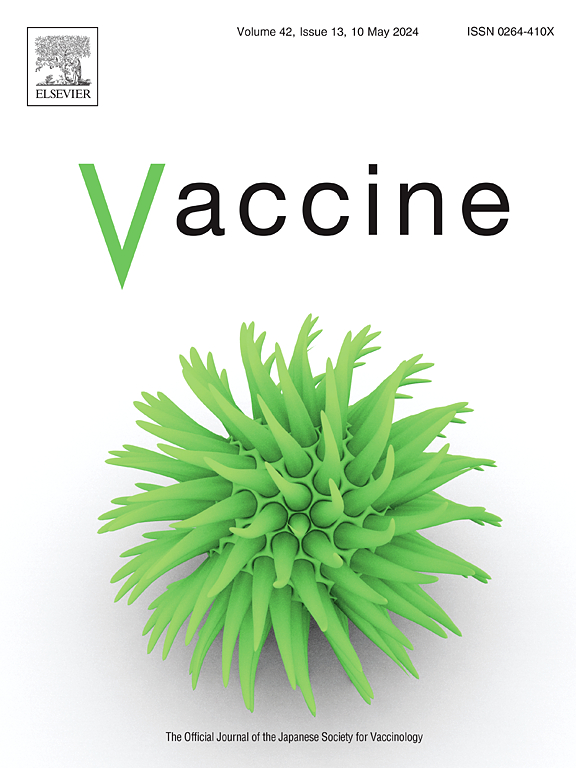Human papillomavirus vaccination coverage and willingness among women in mainland China: A meta-analysis based on the COM-B model
IF 4.5
3区 医学
Q2 IMMUNOLOGY
引用次数: 0
Abstract
Objectives
To estimate human papillomavirus (HPV) vaccination coverage and vaccination willingness among women in mainland China and identify the influencing factors using the Capability, Opportunity, and Motivation model of Behavior (COM![]() B).
B).
Methods
PubMed, Web of Science, Cochrane Library, Embase, and Chinese databases including CNKI, Wanfang Data, VIP, and CBM were searched. Pooled HPV vaccination coverage and willingness were calculated using a random-effects model with 95 % confidence intervals (CIs). Subgroup analyses and meta-regression were performed to explore heterogeneity. The COM-B model and the Theoretical Domains Framework (TDF) were employed to identify factors associated with vaccination coverage and willingness. Dichotomous outcomes were presented as odds ratios (OR) with the corresponding 95 % CIs.
Results
A total of 155 articles, including 10,965,863 mainland Chinese women, were included. The pooled vaccination coverage in 80 included studies was 9.5 % (95 % CI: 7.6 %–11.6 %). Subgroup analysis indicated a higher vaccination rate among women undergoing HPV or cervical cancer screening (16.9 %, 95 % CI: 10.5 %–24.4 %) and among healthcare workers (13.4 %, 95 % CI: 5.6 %–23.8 %). Vaccination willingness, based on 126 studies, was 70.6 % (95 % CI: 66.8 %–74.3 %). Furthermore, the three dimensions of the COM-B model were found to significantly influence both vaccination coverage and willingness (P < 0.05), with capability showed the strongest correlation with HPV vaccination coverage (OR = 2.96, 95 % CI: 2.20–3.99).
Conclusions
There was a significant gap between vaccination willingness and actual coverage among mainland Chinese women. HPV vaccination status of family members or friends and knowledge of HPV and its vaccines were associated with higher vaccination rates.
中国大陆女性人乳头瘤病毒疫苗接种覆盖率和意愿:基于COM-B模型的荟萃分析
目的利用行为能力、机会和动机模型(COMB)评估中国大陆女性人乳头瘤病毒(HPV)疫苗接种覆盖率和接种意愿,并确定影响因素。方法检索spubmed、Web of Science、Cochrane Library、Embase以及中国知网、万方数据、VIP、CBM等中文数据库。使用95%置信区间(ci)的随机效应模型计算合并HPV疫苗接种覆盖率和意愿。采用亚组分析和meta回归来探讨异质性。采用COM-B模型和理论领域框架(TDF)来确定与疫苗接种覆盖率和意愿相关的因素。二分结果以比值比(OR)表示,对应的ci为95%。结果共纳入155篇文献,包括10965863名中国大陆女性。纳入的80项研究的总疫苗接种率为9.5% (95% CI: 7.6% - 11.6%)。亚组分析表明,接受HPV或宫颈癌筛查的妇女(16.9%,95% CI: 10.5% - 24.4%)和卫生保健工作者(13.4%,95% CI: 5.6% - 23.8%)的疫苗接种率较高。基于126项研究,疫苗接种意愿为70.6% (95% CI: 66.8% - 74.3%)。此外,COM-B模型的三个维度对疫苗接种覆盖率和意愿都有显著影响(P <;0.05),能力与HPV疫苗接种率相关性最强(OR = 2.96, 95% CI: 2.20 ~ 3.99)。结论中国大陆女性的疫苗接种意愿与实际覆盖率存在较大差距。家庭成员或朋友的HPV疫苗接种状况以及对HPV及其疫苗的了解与较高的疫苗接种率相关。
本文章由计算机程序翻译,如有差异,请以英文原文为准。
求助全文
约1分钟内获得全文
求助全文
来源期刊

Vaccine
医学-免疫学
CiteScore
8.70
自引率
5.50%
发文量
992
审稿时长
131 days
期刊介绍:
Vaccine is unique in publishing the highest quality science across all disciplines relevant to the field of vaccinology - all original article submissions across basic and clinical research, vaccine manufacturing, history, public policy, behavioral science and ethics, social sciences, safety, and many other related areas are welcomed. The submission categories as given in the Guide for Authors indicate where we receive the most papers. Papers outside these major areas are also welcome and authors are encouraged to contact us with specific questions.
 求助内容:
求助内容: 应助结果提醒方式:
应助结果提醒方式:


